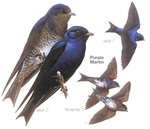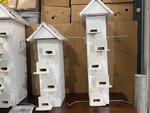Imagine waking up early, brewing yourself a cup of coffee and sitting on your porch to enjoy the sunrise with an early morning breeze. While there, a beautiful symphony plays just outside your door, …
This item is available in full to subscribers.
We have recently launched a new and improved website. To continue reading, you will need to either log into your subscriber account, or purchase a new subscription.
If you had a login with the previous version of our e-edition, then you already have a login here. You just need to reset your password by clicking here.
If you are a current print subscriber, you can set up a free website account by clicking here.
Otherwise, click here to view your options for subscribing.
Please log in to continue |
|


Imagine waking up early, brewing yourself a cup of coffee and sitting on your porch to enjoy the sunrise with an early morning breeze. While there, a beautiful symphony plays just outside your door, arising from a purple martin colony that you foster. With a little hard work, this could be your reality.
On Saturday, Mar. 25, the purple martin seminar was held in the Kalona clothing center to teach spectators about birds in their backyard. The main star was, of course, the purple martin.
The purple martin has grown highly dependent on human intervention. Without people building homes, they would not have a place to live. They’re not an endangered species yet are uncommon. They’re only common in areas where people care for them.
Despite being loved in Kalona and surrounding areas, housing purple martins does not come easy. Des Moines resident and retired DNR manager Tim Gedler was inspired by a purple martin seminar in 2012, and later looked to house martins himself. In his first year, Gedler saw one martin seek refuge during a storm, not staying long. After this, it took nearly seven years for martins to become a mainstay.
Patience is key. Without it, you might never see martins flock to your home. You also must use appropriate homes. The martins nest in groups, meaning the homes must have multiple cavities or gourdes strung together. Martins will not nest in a typical bird home.
You must stay cognizant of where you place the colonies. Gedler recommends 30-120 feet away from your home, 40 feet clear of trees, and a water source within a half mile. If martins visit one year but do not stay, consider slightly moving the homes to better fit these details as martins are picky birds. Be careful of moving successful colonies in the offseason for the exact same reason.
Keeping inventory of the martins is a good way to protect them. Doing daily or every-other-day checks to make sure the nest is dry along with checking the health of baby martins is highly recommended. Continue keeping track of the martins’ progress until they’re 28 days old (or so) and ready to fledge (when they’re ready to fly).
At the 22-day mark, the babies might become eager to jump out of the nest when you open the homes to inspect. Finding ways to plug the opening while still doing checks or having cameras inside the cavities is a great way to combat this. Also, make your life easier by investing in a pulley system to raise and lower the houses. Ladders complicate the process.
If a baby does jump from the nest, do not worry. Gently picking it up and placing it back in the nest from whence it came will not result in a mothers’ rejection.
Gedler also recommends paying attention to weather and knowing how long your martins go without eating. If the temperature is 50 degrees or lower, or it rains, for three consecutive days the martins might be in the process of starving.
His tactic for feeding them is by tossing dead crickets into the air. He might do it 100 times before the birds catch the cricket midair. Eventually, with a little training, he can toss just a few in the air and put the rest in the feeding tray and the birds will come down to eat. If the birds are too starved, it is best to put the crickets directly into their homes. Gedler mentioned storing upwards of 1,000 crickets in his freezer for occasions like these.
It is important to remember, different strokes for different birds. It is important to know which birds you’re trying to foster in your yard before making any ultimate plans.
Food is a huge factor in this process. If you want to see hummingbirds in your backyard, make sure to have specific feeders for them and replace their feed every single day. Especially in the summer heat, their food can become sticky and nasty in less than a day.
If you want to attract more than one species of bird, sunflower seeds are a good bet. Another is eggshells, but don’t blindly throw eggshells into the yard. A trick that Ivan Ray Miller recommended is baking a pot of eggshells, to at least 150 degrees, to irradicate any traces of salmonella. Then, crush and leave them outside for your birds. Almost all birds love eggshells as they’re a great source of calcium, which birds need a lot.
Knowing what types of birds live in your area and then researching to put the proper bird houses out for them is essential to creating a hospitable backyard. A purple martin colony compared to a blue bird house are polar opposites.
So, what else can you do to create a hospitable backyard? Fresh water is as important as food. A bird bath is a good start. A heated bird bath is even better, according to Miller, who runs one without electricity on his property. Miller also recommended having a rock sticking out of the bird bath, so the birds have a nice, safe place to stand around the water.
There are many threats that can prevent your backyard from being a safe space for birds. Some birds, like sparrows, will take over a pre-existing nest and kill babies. The speakers at the purple martin seminar offered a few tricks to deal with these pesky birds. There are traps to catch and release them elsewhere, or a specific nest for them can be created, knowing martins will avoid it and the sparrow can take over.
Other predatory birds can wreak havoc on your backyard birds, like owls and hawks. These are harder to deal with, but netting can be put around a nest so that a bigger bird cannot get underneath, yet the smaller birds you want to house can.
You also want to protect your birds from predators like raccoons, opossums, cats, and snakes. The more birds you bring in, the more predators you attract. It is highly recommended to use predator guards on every bird home and feeder. Predator guards can prevent predators from scurrying up the poles to find dinner.
Squirrels pose a threat to bird feeders and can be prevented with more predator guards. Another trick to keeping squirrels out of feeders is keeping feeders out from under trees. Squirrels are crafty and will jump from tree to feeder if they can’t climb up the pole.
Another threat to martins are mites. Mites will suck the blood out of martins and cause some babies to leap from nests too early. The speakers at the seminar recommended using a quarter teaspoon of Sevin Dust as soon as an egg is seen in a nest. It can be spread around the edges of the home, underneath the nest. Unless you see an infestation, one treatment is good enough. Doing this will greatly prevent mite infestations, but it is hard to fully prevent all mites.
Anyone can become an advocate to help protect birds. Being an advocate in your own backyard is a great start and fantastic way to ensure the health and safety all kinds of birds.